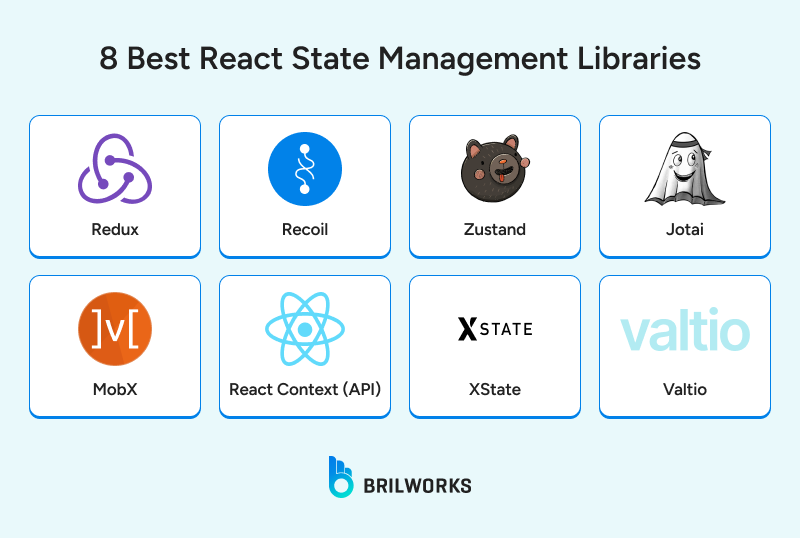COOPERATION MODEL
ARTIFICIAL INTELLIGENCE
PRODUCT ENGINEERING
DevOps & Cloud
LOW-CODE/NO-CODE DEVELOPMENT
INDUSTRY
FRONTEND DEVELOPMENT
CLOUD DEVELOPMENT
MOBILE APP DEVELOPMENT
LOW CODE/ NO CODE DEVELOPMENT
EMERGING TECHNOLOGIES








As React applications scale in 2025, state management is more critical than ever. With React Server Components, concurrent rendering, and the demand for seamless user experiences, choosing the right state management library can directly impact app performance and maintainability.
The challenge is that React doesn’t enforce a single way of handling state. This flexibility means developers must carefully evaluate which library best fits their needs.
In this guide, we’ll compare eight of the most popular React state management libraries—from established solutions like Redux and MobX to lightweight contenders such as Zustand and Jotai. Along the way, we’ll highlight their pros and cons, adoption trends, and best use cases so you can make the right choice for your next project.


Redux has long been the standard for managing state in React applications. It enforces a unidirectional data flow, where state updates happen through pure reducer functions. This predictable pattern makes debugging easier and pairs well with tools like the Redux DevTools.
Pros:
Mature ecosystem with extensive middleware support
Great for complex applications requiring centralized control
Large community and long-term stability
Cons:
Boilerplate code can slow down small projects
Learning curve is steeper for beginners
If you’re building enterprise-grade apps or already working with Flux architecture and reducer functions, Redux still provides unmatched reliability.

Recoil was created by Facebook to simplify state management with primitives like atoms and selectors. It integrates tightly with React features like Suspense, which makes it ideal for apps with asynchronous data fetching.
Pros:
Minimal setup compared to Redux
Built-in support for derived state
Works seamlessly with React Suspense
Cons:
Community adoption has slowed due to fewer updates
Smaller ecosystem than Redux
If you’re working on projects that rely heavily on atoms and selectors or Suspense, Recoil is still a good fit.

Zustand is a small but powerful library that uses hooks to manage state. Its API is simple, requiring very little boilerplate, yet it can scale to support larger applications.
Pros:
Extremely lightweight and fast
Intuitive API based on hooks
Flexible for both local and global state
Cons:
Ecosystem is smaller than Redux or MobX
Less suited for very large enterprise apps
Developed by the creators of Jotai and React Spring, Zustand has gained traction among developers who want simplicity without losing scalability.

Jotai focuses on atomic state management, letting you build applications with minimal and independent pieces of state. Each atom is a single source of truth, which helps avoid unnecessary re-renders.
Pros:
Minimalistic and flexible
Fine-grained control over state updates
Built by the Zustand team
Cons:
Still maturing compared to Redux or MobX
Smaller user base
If your project values modularity and performance, Jotai offers a clean and modern alternative.

MobX uses observables and a reactive programming model, making state updates automatic when data changes. This pattern reduces boilerplate and often results in cleaner code.
Pros:
Minimal configuration needed
Great for applications with complex relationships between states
Embraces observables and reactive programming
Cons:
Can feel “magical” and harder to debug
Less strict than Redux, which can lead to inconsistent patterns
MobX remains a strong choice for projects where rapid development and simplicity matter more than strict architecture.

React’s built-in Context API allows developers to share data across components without prop drilling. While not a full replacement for dedicated libraries, it works well for small-scale apps or handling theming and user authentication.
Pros:
No external dependency required
Perfect for simple use cases like themes or user sessions
Easy to learn and implement
Cons:
Not optimized for complex or frequently updated state
Can cause unnecessary re-renders if not used carefully
For quick state sharing, Context API with createContext and useContext is often enough.
Apollo Client is primarily used for managing GraphQL data, but it doubles as a state management tool. It caches data efficiently and integrates well with React.
Pros:
Ideal for GraphQL-based applications
Strong ecosystem and community support
Handles both local and remote data seamlessly
Cons:
Overkill if you’re not using GraphQL
Slightly larger bundle size
For apps where GraphQL is the primary data source, Apollo can replace traditional state managers entirely.

Valtio provides a proxy-based state management approach. It lets you mutate state directly, and React automatically tracks dependencies to update components.
Pros:
Simple, mutable API
Proxy-based model feels natural for many developers
Reduces boilerplate significantly
Cons:
Still evolving compared to mature options like Redux
Community is smaller
Valtio is a good option if you want simplicity without losing reactivity.
Based on surveys like State of JS 2024 and GitHub activity:
Redux remains dominant in enterprise apps due to its stability and tooling.
Zustand and Jotai have surged in popularity for their simplicity and modern APIs.
Recoil adoption has slowed, largely because of fewer updates.
MobX retains a loyal base, especially for teams favoring reactive programming.
These trends show that while Redux is still a safe choice, newer libraries are quickly gaining traction for projects where speed and simplicity are priorities.
Here’s a side-by-side look at how the leading libraries compare:
|
Library |
Bundle Size |
Complexity |
Best For |
Ecosystem Maturity |
|
Redux |
Medium |
High |
Large-scale, enterprise apps |
Very mature |
|
Recoil |
Small |
Medium |
Async data + Suspense integration |
Moderate |
|
Zustand |
Very small |
Low |
Small to medium apps |
Growing fast |
|
Jotai |
Very small |
Low |
Modular apps, fine-grained state |
Growing |
|
MobX |
Medium |
Medium |
Complex relational state |
Mature |
|
Context |
Built-in |
Low |
Simple state like themes/auth |
Native to React |
|
Apollo |
Large |
Medium |
GraphQL-heavy apps |
Mature |
|
Valtio |
Small |
Low |
Developers preferring direct mutations |
Emerging |
This comparison makes it easier to match a library with your app’s size, complexity, and long-term needs.
There’s no one-size-fits-all answer. If you’re building a large enterprise project, Redux is still the most reliable option. For modern, lightweight apps, Zustand and Jotai are worth serious consideration. Apollo Client shines in GraphQL-heavy environments, while Context API remains the go-to for simple use cases.
When deciding which library to adopt, consider:
App size and complexity: small apps may work fine with Context API, while larger apps benefit from Redux or MobX.
Team expertise: if your developers are already comfortable with reducers, Redux will be easier to adopt.
Future scalability: libraries like Zustand and Jotai offer flexibility without overhead.
Ecosystem and tooling: mature libraries like Redux and Apollo provide richer debugging and middleware support.
Answering these questions upfront can save time and prevent costly rewrites later.
State management in React has evolved significantly, and in 2025 you have more choices than ever. Whether you need the predictability of Redux, the modern simplicity of Zustand and Jotai, or the built-in ease of Context API, the best choice depends on your app’s goals and scale.
If you’re planning a new React project and want expert guidance on selecting the right state manager, our team at Brilworks can help. We assist companies to hire ReactJS developers who not only write clean code but also design scalable state architectures.
Get In Touch
Contact us for your software development requirements
Get In Touch
Contact us for your software development requirements